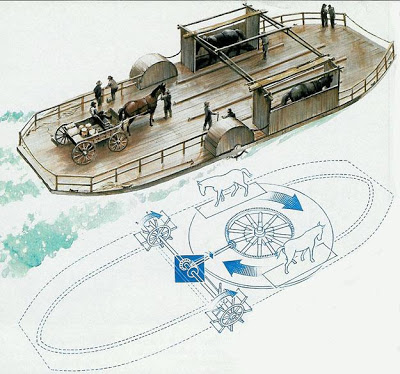
So, last night I was unable to sleep thanks to my kneecap relocation and I pulled off, at random, a National Geographic issue from October 1989 from the shelf. Lo and behold I found a magnificent little article on this Horse Powered Ferry Boat discovered in Lake Champlain. Here is an updated article on it from ShipwreckWorld.com:
The horse-powered ferryboat, though patented in 1819, can trace its origin of design back to the time of the Romans. The Roman ox boat was an early war vessel propelled by a team of oxen. During the 1700’s, boats propelled by horses could be found on various rivers and canals of Europe. It was a natural course of events that those people immigrating to America from Europe would bring their knowledge of horse powered boats to our lakes and rivers. By the early 1800’s, horse powered boats could be found on Lake Champlain and the Hudson River. By the 1820’s, this mode of transportation had spread to the Ohio and Mississippi Rivers, the Great Lakes, and to several other rivers and lakes in the Northeast. This type of vessel was generally utilized for journeys of only a few miles.
The horse powered boat was discovered by Jim Kennard and Scott Hill in the Fall of 1983. The vessel is basic in its design and construction and has a length of 63 feet and a beam of 18 feet. In 1819, a passenger wrote a description of his observations while travelling on a similar horse powered ferryboat between Albany and Troy on the Hudson River
"The ferry boat is of a most singular construction. A platform covers a wide flat boat. Underneath the platform, there is a large horizontal solid wheel, which extends to the sides of the boat; and there the platform or deck, is cut through and removed, so as to afford sufficient room, for two horses to stand on the flat surface of the wheel, one horse on each side, and parallel to the gunwale of the boat. The horses are harnessed, in the usual manner for teams - – whiffle trees being attached to stout iron bars, fixed horizontally at a proper height, into posts, which are a part of the fixed portion of the boat. The horses look in opposite directions, one to the bow, and the other to the stern; their feet take hold of channels or grooves, cut in the wheels, in the direction of radii; they press forward and although they advance not, any more than a squirrel, in a revolving cage, their feet cause the horizontal wheel to revolve, in a direction opposite to that of their own apparent motion; this by a connection of cogs, moves tow vertical wheels, one on each wing of the boat, and these being constructed like paddle wheels of steam-boats, produce the same effect, and propel the boat forward. The horses are covered by a roof, furnished with curtains, to protect them in bad weather; and do not appear to labor harder than common draft horses, with a heavy load."
During the mid 1800’s, the animal treadmill design became the preferred method of propulsion in horse powered ferryboats. Horses were yoked together on each side of the deck. Their power was transmitted directly to the paddle wheels via the treadmills. It appears that the treadmill design persisted up to the end of the horse-powered ferryboats around 1900.
In 1841, the "superior horse boat EAGLE", was running three trips a day between Basin Harbor, Vermont and Westport, New York, a short crossing of about 3 miles. It is believed that this boat utilized the horizontal flywheel design. This may be the horse powered ferryboat that we discovered. The EAGLE may have broken its mooring lines during the winter and could have been carried along with the ice drifting northward up the lake, eventually sinking in Burlington Bay.
The story of this horse powered ferry boat with many underwater pictures appeared in the October 1989 issue of National Geographic Magazine.
I've always been interested in historical archaeology, and during the drought of '88-'89, with the help of a marine archaeologist from Baton Rouge, I located the wreck site and debris field of a Civil War 110-ton sternwheeler packet boat that sank in the Mississippi in late 1862. Tons of fun, if you don't mind the hard work and perspiration. But a two horsepower sidewheeler? I'd never heard of such until last night's pain-induced insomnia. They date back to Roman times. Way cool.
4 comments:
There are many wrecks in Champlain to visit, as it was the highway north and a battle ground in the 1750's, 1770-1790, and 1812.
Side note, there is a couple of Higgins boats still working the lake.
Great historical piece, I love technical artifacts and this shows when oil and energy is too expensive to use, we will be able to recreate these types of contrivances to travel and barter across lakes and rivers. Take care of that knee, had the same thing happen to me, in fact I have noticed you and me seem to have the same illnesses, we both come from Michigan, coincidence?
Kevin III
Old ideas are the genesis of new ideas. By studying the past we can see the successes and mistakes made in the past and find ways to improve on the present. Because our present day schools do not appreciate the value of history our children are ignorant of the success and mistakes of the past. They are also ignorant of the sacrifice of the founding fathers and mothers to provide us our liberty. Please continue to show us our past and challenge the present to preserve our liberty.
Thanks this was most interesting.
Post a Comment